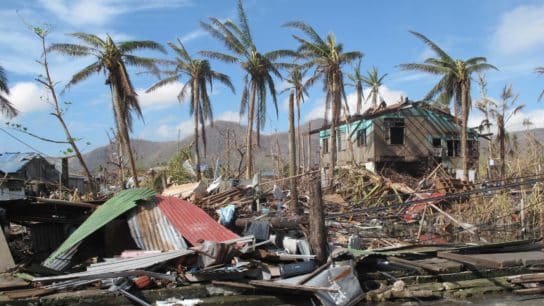India has been battling a prolonged heatwave that scientists say has been worsened by human-driven climate change.
—
India’s capital New Delhi recorded an all-time high temperature of 52.9C on Wednesday, prompting authorities to move classes online and urging residents to stay indoors.
For nearly two weeks, parts of the country have sweltered in a severe heatwave that the India Meteorological Department (IDM) says is likely to “reduce gradually” from Thursday onwards. Temperatures ranged between 46-50C in the Northwest and between 42-46C in parts of West, Central, and East India. The latter is expected to see temperatures soar by 2-3C during the next three days, gradually falling by 3C-4C thereafter.
On Wednesday, monitoring stations across the capital recorded maximum temperatures ranging between 45.2-49.1C, though an observatory located in Mungeshpur reported a record high of 52.9C. “It could be due to error in the sensor or the local factor,” the IMD said in a press release, adding that it was examining the data and sensors. Minimum temperatures at night are only dropping to roughly 30C, providing little relief to residents.
As reported by the Times of India, power demand peaked to 8,302MW on Wednesday, crossing the previous record set on May 22.
Temperatures on Wednesday also reached an all-time high for the month in many cities in Uttar Pradesh, a state in northern India bordering Delhi – including Varanasi (46.7C), Churk (47C), Babatpur (47.4C), Sultanpur (46C) – and Himachal Pradesh, India’s northernmost state.
India has been battling with the devastating consequences of anthropogenic climate change and currently ranks ninth out of the world’s top-50 states most at risk from climate change hazards. According to the National Centre for Science and Environment’s 2023 climate breakdown, India had its warmest-ever August and September in 122 years.
Earlier this month, authorities confirmed that April was Northeast India’s hottest on record, with IMD chief Mrutyunjay Mohapatra saying the heat “wasn’t entirely unexpected.” Speaking with Times of India, Mohapatra said the conditions were partly to blame on El Niño, a weather pattern associated with the unusual warming of surface waters in the Pacific Ocean, as well as on an anti-cyclonic circulation in central Bay of Bengal associated with hot and dry conditions in eastern India.
Stress on human bodies caused by heat prevents normal daily activities and our ability to cool down properly. Areas that generally have more humidity can also put lives at risk. Sweat helps our bodies cool off, but humidity changes the way sweat evaporates from the body. Not being able to cool down puts people’s health at risk, and can lead to increased cardiovascular and respiratory complications, dehydration, heatstroke, higher blood pressure, and sleep deprivation.
More on the topic: How Extreme Hot Weather Events Will Impact Earth for Years to Come
Dozens of people have died in the country since the onset of the heatwave, according to media reports, though authorities have yet to confirm the numbers. Elevated temperatures threaten especially the young, elderly, and those with compromised immune systems. Outdoor workers are also particularly at risk.
Speaking with The Economic Times, 49-year-old Sanjay Verma, who drives across south Delhi for eight hours delivering food, said the sweltering heat is slowing him down. “I take a break and drink water every 30 minutes, otherwise I will faint or drop dead.”
Local media also reported that more than 100 students and teachers fainted during classes due to the intense heat, with many schools opting for online learning. Last week, Delhi authorities ordered schools to shut with “immediate effect.”
Some experts have also blamed the heat for a low turnout at polling stations. India’s general election, the world’s largest democratic exercise with nearly one billion people eligible to vote, began last month and will continue until June 1. With environmental concerns reaching critical levels, the decisions made by India’s elected officials will have far-reaching implications, not just within its borders but also for the future of our planet.
Featured image: igorovsyannykov/Pixabay
—
UPDATE (June 3, 2024): An investigation by the Indian Meteorological Department (IMD) found that Wednesday’s reading by the weather station at Mungeshpur was too high by 3C.
How can I contribute to a more sustainable planet?
- 🗳️ Vote for Climate Action: Exercise your democratic rights by supporting candidates and policies that prioritize climate change mitigation and environmental protection. Stay informed with Earth.Org’s election coverage.
- 👣 Reduce Your Carbon Footprint: Make conscious choices to reduce your carbon footprint. Opt for renewable energy sources, conserve energy at home, use public transportation or carpool, and embrace sustainable practices like recycling and composting.
- 💰 Support Environmental Organizations: Join forces with organizations like Earth.Org and its NGO partners, dedicated to educating the public on environmental issues and solutions, supporting conservation efforts, holding those responsible accountable, and advocating for effective environmental solutions. Your support can amplify their efforts and drive positive change.
- 🌱 Embrace Sustainable Habits: Make sustainable choices in your everyday life. Reduce single-use plastics, choose eco-friendly products, prioritize a plant-based diet and reduce meat consumption, and opt for sustainable fashion and transportation. Small changes can have a big impact.
- 💬 Be Vocal, Engage and Educate Others: Spread awareness about the climate crisis and the importance of environmental stewardship. Engage in conversations, share information, and inspire others to take action. Together, we can create a global movement for a sustainable future.
- 🪧 Stand with Climate Activists: Show your support for activists on the frontlines of climate action. Attend peaceful protests, rallies, and marches, or join online campaigns to raise awareness and demand policy changes. By amplifying their voices, you contribute to building a stronger movement for climate justice and a sustainable future.
For more actionable steps, visit our ‘What Can I do?‘ page.
This story is funded by readers like you
Our non-profit newsroom provides climate coverage free of charge and advertising. Your one-off or monthly donations play a crucial role in supporting our operations, expanding our reach, and maintaining our editorial independence.
About EO | Mission Statement | Impact & Reach | Write for us














